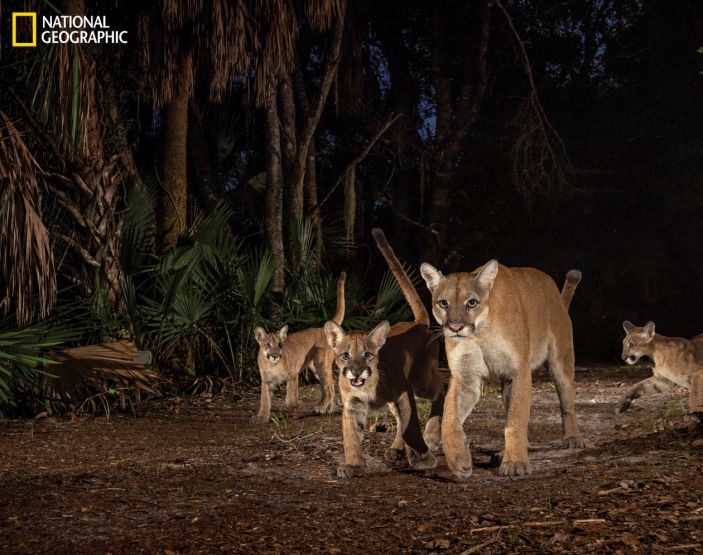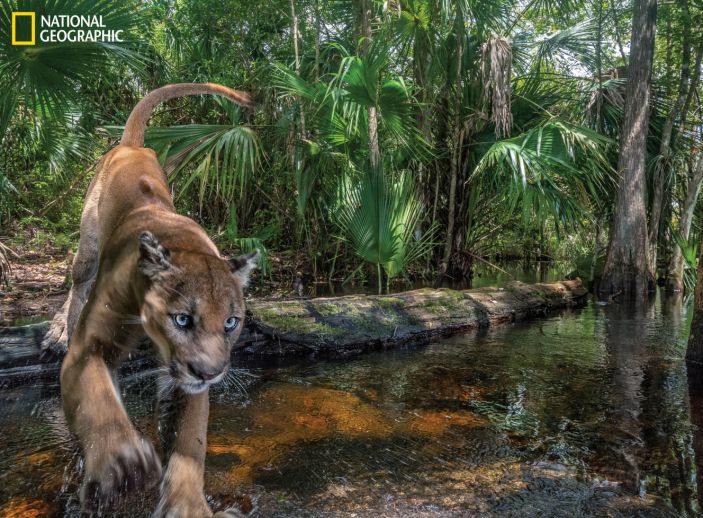 A male panther leaps over a creek at Florida Panther National Wildlife Refuge in southwestern Florida. The rarely seen cats, which number only around 200, are reclaiming territory north of the Everglades, but their habitat is threatened by encroaching suburban sprawl. Photo courtesy Carlton Ward, Jr./National Geographic. Used with permission.
A male panther leaps over a creek at Florida Panther National Wildlife Refuge in southwestern Florida. The rarely seen cats, which number only around 200, are reclaiming territory north of the Everglades, but their habitat is threatened by encroaching suburban sprawl. Photo courtesy Carlton Ward, Jr./National Geographic. Used with permission.
Aggressive hunting and unchecked development cut the population of the endangered Florida panther to fewer than 30 in the 1970s — but thanks to conservation efforts, the population is now approximately 200, mainly in a stretch of contiguous land south of the Caloosahatchee River.
What’s new: A stunning photo essay by Carlton Ward, Jr. for National Geographic documents the return of the elusive cat.
Get market news worthy of your time with Axios Markets. Subscribe for free.
Ward told Axios that he’s excited to share these hard-won, never-before-seen photos with the world to create a “greater level of empathy” for the rarely-seen animal and draw more resources toward conservation.
“If I click through these,” he said, “I don’t think there’s a single picture in here from a camera trap that took less than a year to capture.”
“That’s still 200 elusive, nocturnal, forest-dwelling animals that are spread across millions of acres of land,” he added.
How Ward made the photos: After talking to state biologists and researchers about movements and habitat, he considered aesthetics — he wanted to capture them in their natural habitats.
Ward created mini-studios in the woods and swamps, with lights and motion-trigger cameras.
The cameras captured hundreds and sometimes thousands of images per month. The vast majority were useless, triggered by rain or falling leaves. He lost cameras to fire, flooding, a falling tree, a trespassing thief and a poacher, who shot one.
 A female and three kittens explore Corkscrew Swamp Sanctuary, a reserve of old-growth cypress forest surrounded by encroaching suburbs on three sides. Many of these camera trap images took years to capture because of the cats’ rarity, their unpredictable movements, and the difficulty involved in getting the right lighting. Florida’s weather can be a challenge too: One camera was lost during a hurricane but was later recovered. Photo courtesy Carlton Ward, Jr./National Geographic. Used with permission.
A female and three kittens explore Corkscrew Swamp Sanctuary, a reserve of old-growth cypress forest surrounded by encroaching suburbs on three sides. Many of these camera trap images took years to capture because of the cats’ rarity, their unpredictable movements, and the difficulty involved in getting the right lighting. Florida’s weather can be a challenge too: One camera was lost during a hurricane but was later recovered. Photo courtesy Carlton Ward, Jr./National Geographic. Used with permission.
What’s next: As their population grows, the Florida panther will need more territory to roam. Ward and others have spent years trying to create and preserve the Florida Wildlife Corridor, a network of public and private land that runs throughout the state.
Ward said the corridor bottlenecks between the eastern edge of the Tampa Bay region, Lakeland and Orlando, as orange groves give way to rooftops and strawberry fields to distribution centers.
Unless greenways are preserved, the only safe passage for Florida panthers through the I-4 corridor will be east of Orlando.

Comments
No comments yet. Be the first to react!